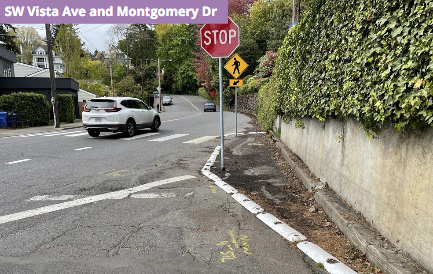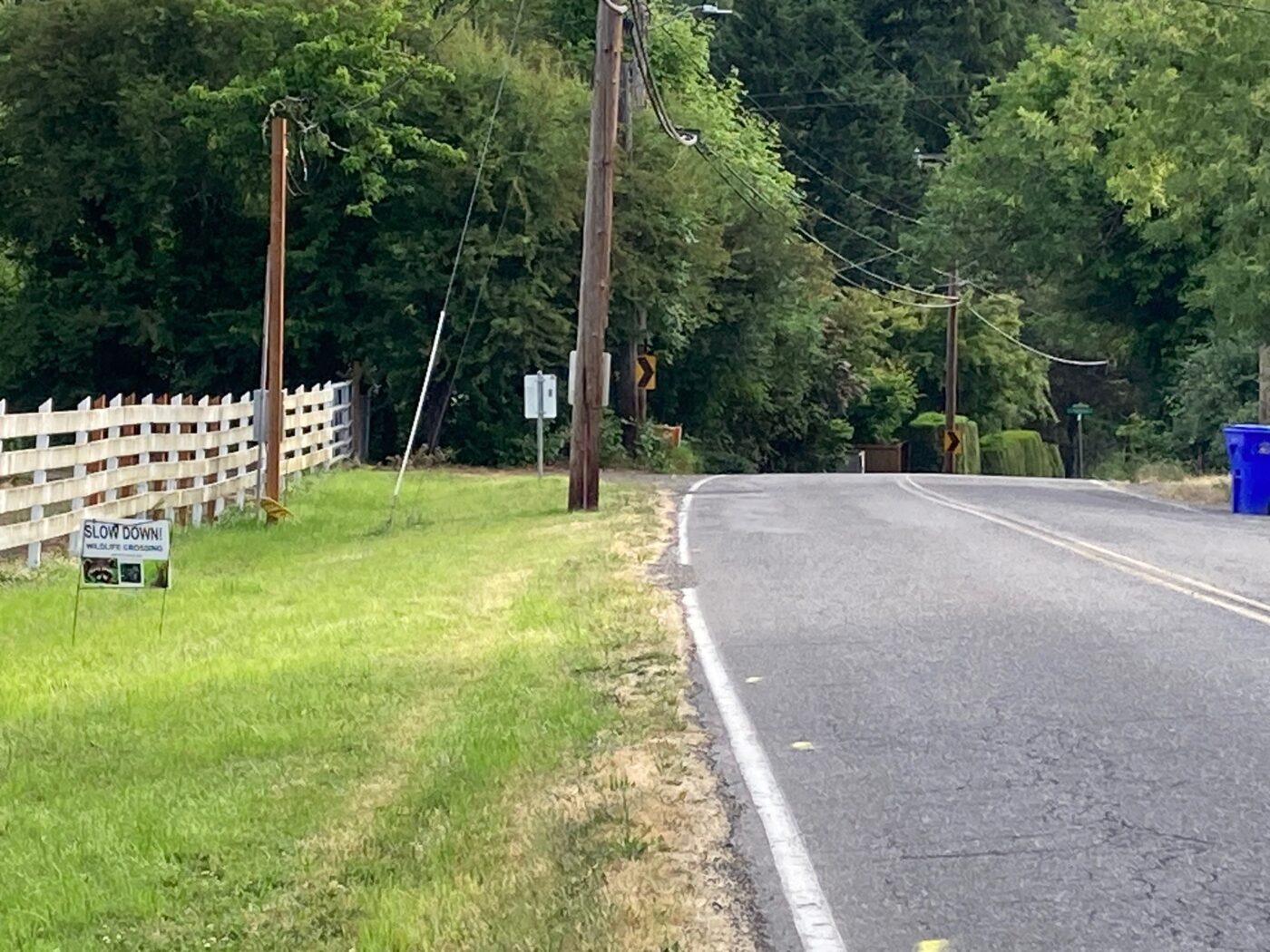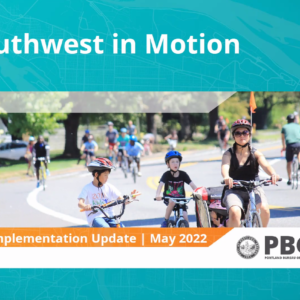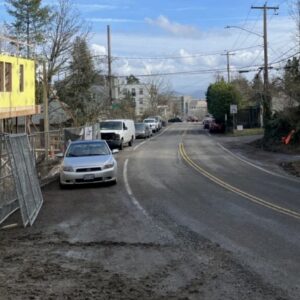
The Portland Bureau of Transportation (PBOT) released its progress report for the Southwest in Motion (SWIM) plan last month and announced that nine projects and 21 crossing enhancements have been completed since the plan was adopted in December, 2019.
The report opened by noting that “less of the planned bike network has been built in Southwest Portland compared to other areas in the city.” 29% of the southwest’s network has been built compared to 54% in the Central City and 42% citywide.
As BikePortland previously reported, SWIM stakeholders have been frustrated over the delay of the plan’s two-year progress report, which they expected in the fall of 2021, and also with the difficulty in keeping track of project implementation due to outdated information on the website. The progress report includes maps and lists of completed and In-progress projects and appears to address these issues.
With so little funding and less in the future why can’t the taxpayers and customers be involved in how it gets spent?
– Keith Liden, cycling advocate
Also included in last month’s announcement was a survey requesting input to help select the next round of projects to be implemented. The survey lists eight potential projects and requests that the respondent select their top three. (A couple of the projects are bicycle infrastructure improvements.)
The survey might be an attempt to address the community’s feeling of being shut out from ongoing project selection and design. In a letter earlier this year, stakeholders had expressed concerns over “having virtually no knowledge or involvement in project prioritization, selection, or design until they are announced.”
Bicycle advocate, Keith Liden (featured in a recent BikePortland post about the bike lane gap at SW 6th Ave and Hwy 405) thought the survey was a step in the right direction, but wrote PBOT earlier this month to say that he “felt constrained by the format” which didn’t allow comments on designs. He was also frustrated that PBOT didn’t seem to take into account the varying demand for different projects. As an example, he wondered why Boones Ferry projects were included in the list of eight choices, but not projects on the more heavily used Terwilliger Blvd:
Terwilliger is a busy bike and pedestrian route with gaps that have gone unaddressed since the 90s. The cost of many of these identified gaps are no greater than other projects on the PBOT survey list.
Liden summed up his thoughts in an email to me this morning, “We really seem to be kept at arms length. With so little funding and less in the future why can’t the taxpayers and customers be involved in how it gets spent?”



The progress report also updated the status of several “Policy and Program Recommendations” from the 2019 plan. That original plan was notable for its insight into challenges unique to southwest Portland such as the lack of formal stormwater conveyance and hilly terrain. The City of Portland often cites these existing conditions as an explanation for why nearly 70% of the area’s collectors and arterials lack sidewalks.
So the first updated recommendation, about Development Review and frontage improvements, caught my attention. Maybe I’m grasping at straws, but it included a single word which might have an important policy ramification, “specific:”
As part of the Streets 2035 right-of-way project, clarify how to reconcile frontage requirements as a part of development review in response to the context of specific streets in Southwest Portland.
The “context of specific streets” seems to me to be a change from business as usual. Currently, the Development Review office within PBOT decides on frontage improvements like bike lanes or sidewalks on a project-by-project basis as the building projects arise. There is no overarching area street plan.
The progress report appears to be recommending that Streets 2035 develop a plan ahead of time for certain specific streets, rather than just providing a rubric or framework for reviewing bureaus to make decisions. (Streets 2035 is a design framework which will provide guidelines for sometimes conflicting infrastructure requirements in the right-of-way.)

For example, say 300 new houses were going in on the Alpenrose property on SW Shattuck Rd. Rather than neighbors wondering for years whether the developers will be required to build a sidewalk on the property’s Shattuck frontage, SWIM appears to suggest that Streets 2035 should determine the street treatment ahead of time, outside of the pressure of active development.
The “context of specific streets” just might be a bit of insider baseball which could lead to more intentional sidewalk and bike lane decisions. The progress report says “status update forthcoming.”
Other policy recommendations have already been acted upon. On neighborhood traffic calming, PBOT has worked with the Fire Bureau to reduce cut-through traffic with speed bumps on SW Broadway Dr and SW 45th Ave. PBOT is also piloting two traffic chicane projects on SW Burlingame Ave and SW Dolph Ct.
The SWIM project survey closes this Sunday, June 25. A link to the survey and project description, as well as the report can be found on the SWIM project website.






Thanks for reading.
BikePortland has served this community with independent community journalism since 2005. We rely on subscriptions from readers like you to survive. Your financial support is vital in keeping this valuable resource alive and well.
Please subscribe today to strengthen and expand our work.
This is very frustrating as a Southwest Portland resident. We have always been neglected by PBOT as they mainly turn their attention to East Portland and the Central City. I would still like to see Terwilliger Blvd get similar treatment like on Capital Hwy from the I-5 to Boones Ferry Rd.
The “context of specific streets” just might be a bit of insider baseball which could lead to more intentional sidewalk and bike lane decisions. The progress report says “status update forthcoming.”
Sounds like the next pitch will be a “curveball”. Be ready…..
PBOT’s own research for PedPDX showed other cities planned out what streets should look like with future development, so developers and users alike knew what was required. PBOT has resisted this for YEARS. I will now hold breath until it happens.
Also, ANY plans which continue to require pedestrians share the road surface with cars should be immediately rejected.
I think you mean the Pedestrian Design Guide, which did a comparable cities survey. (Michelle Marx was in charge of both efforts.) Austin was one of the cities interviewed, if I remember correctly. But yes, other cities have made policies intended to gird against Nollan/Dolan suits. It is noteworthy that PBOT surveyed that question.
If runoff management is going to be such an ongoing excuse for not dealing with alternative transportation needs then they need to put a very specific plan in place for how to address that. Quickly.
I can understand saying this is the plan, we are struggling with funding. Fair enough. But this constant giving up without even trying is disgusting and frankly just feels grossly incompetent.
I for one am not going to hold my breath following the change in wording. It seems like every couple years they try a new phrase to distract people from their ongoing lack of effort.
Without a pre-existing plan PBOT starts at a disadvantage when it comes to negotiations with developers. Such as the ones for the Alpenrose site. If they already had one they would be in a much stronger position to make demands.
Hi HJ,
You are touching upon an important point that I haven’t yet worked into a story. A developer can decide to fight in court any frontage requirement PBOT’s Development Review requires of them citing a body of jurisprudence called “Nollan/Dolan.”
The best way for a city to protect against Nollan/Dolan challenges is to demonstrate that the exaction for frontage improvements is part of an existing, consistently enforced, plan. In other words, the city is not singling out a specific developer for a “taking,” but rather requiring the same thing of everyone developing property at a location.
Portland doesn’t do this currently, and is thus very exposed to Nollan/Dolan challenges. I’ve talked to people who think that part of the reason development review goes light on enforcing frontage requirements is out of the city’s fear of a Nollan/Dolan challenge. That, and the fact that the city has neglected, for over half a century, to build the stormwater infrastructure that southwest Portland needs.
I get irritated with development review (and as my NA transpo committee chair appealed a planned development all the way to the state Land Use Board of Appeals in which the developer’s attorney was justifying the city’s approval with Nollan/Dolan arguments), but the problem is really political. The city council hides behind Dev Rev and kicks the can down the road decade after decade.
Bikes/peds starts at a disadvantage WITHIN PBOT vs. DR: the revised PedPDX guide seems mainly designed to smooth the DR path as opposed to promoting safety. DR uses Nollan/Dolan as an excuse, and interprets City Hall directives on density to mean do NOT ask for things that raise developer costs, and slow development or cause suits (in SW at least). So they roll over, and toss as many excuses out as they feel justified. I am sure developers feel otherwise, but then they complain about most costs. Alpenrose is a great example; the idea that no sidewalks would be required inside the development, let alone outside, is an abdication of their responsibilities. In most Texas cities, the developer would be told exactly how much of needed infrastructure they would be paying for – stormwater, sidewalks, stop lights at entrance, etc. That’s because they have a standard and apply it to each project, and it gets supported in court.
It seems that larger asks occur where it would be unseemly or too obvious to have nothing, or local protest has made it clear something needs be done to avoid larger mitigations. My personal theory on SW Gibbs is 1) they thought they’d get away with it except for those meddling kids and 2) they could not allow the developer to overdeliver lest it expose DR/Alternative Review to lawsuits over similar situations where improvements were denied, yet some were possible. I don’t think they would enjoy the discovery process that much.
As Lisa points out this is a POLITICAL issue, yet middle managers at PBOT have been deciding public policy for us with no oversight.
Way back in 2010 or so, Mayor Sam Adams instituted “budget mapping” to show where money was being spent geographically, bureau by bureau. At first, each bureau divided each part of the city in it’s unique way, but eventually the budget office got most of the bureaus to divide their funding by the 7 district coalitions (the police are the most resistant, to this day, but even PBOT is a bit of a pain.)
The long and the short of it is, most bureaus are inadequately funded, particularly since the property tax rollbacks of 1991/2, and cannot fund what they are mandated by City Council to fund. The Fire Dept is probably the best funded followed by Water and BES (sewers), but planning, PBOT, Parks, and most of the rest are well below “full funding” on most years. The sooner you realize this, the sooner you can really start to look for long-term solutions for your issues.
On good years, the downtown “Central City” district (which is technically part of 4 of the 7 district coalitions: NWNW, SWNI, SEUL, & NECN) got nearly full funding or even over-full funding on most years, thanks to the ongoing success of PBA and others (including PSU, BTA/ST, OW, etc) being the squeakiest of wheels in lobbying city officials; but on some years and for some bureaus, even downtown got less than it needed, sometimes far less.
And the other parts of the city? We were (and still are) chasing after the crumbs left over from downtown. When we of the East Portland Action Plan set out in 2009 to lobby city agencies for more adequate city funding, we knew full well we would never ever get our “full share”; we also knew that if we got an increasing share that we would be taking away funding from other grossly inadequately-funded districts. We were OK with that, although we knew it wouldn’t make us many friends from outside our district unless we helped gang up against downtown, which we eventually did by 2012 through the bureau/budget advisory committees.
We also learned something about staffing. Apparently for many years, PBOT and Planning were sending us their least good and most useless planning staff – we eventually figured this out talking with other districts and from disgruntled internal employees at PBOT and Planning (there are always plenty with an ax to grind), whereas apparently parks, police and street maintenance were sending us their best employees. We eventually got much better service for our proverbial buck, as inadequate as it was, by asking for and getting certain staff by name to serve on projects in East Portland or as agency liaisons.
Yes, there are some incredibly brilliant staff at PBOT. There’s also a lot of chaff. As a member of the public, can you tell the difference? I know I can’t.
YES. The good ones try to do their jobs, and don’t make excuses why they can’t.
I’m not going to fill out the survey, which feels like more performative involvement (“You had your say – we sent you a survey”).
I also think it’s hilarious that PBOT shows a photo of the Magnolia Trail crossing of SW 45th, which is the some of the most bike-unfriendly design I’ve ever seen. The raised curbs and wands push a cyclist into the narrow travel lane – there’s no way to go behind the wands and it’s really easy to plow into the curbs and crash. I’ve asked the city to move the curbs back but they are not interested. It’s yet another example of experimental street design that is actually dangerous to cyclists.
Speaking of middle managers – I was reading this audit of a PBOT employee (https://www.portland.gov/audit-services/news/2023/6/14/fraud-hotline-report-tips-about-transportation-manager-alleged) and noted the subject was Kurt Krueger; Krueger is considered by some transportation activists to be a straight shooter, and by others to be the main problem in SW. If it’s the latter, some of Development Review’s poor decisions could be explained by this sentence:
“The employee has a high-level level function with minimal supervision. The position has substantial authority to make significant decisions with a high consequence of error.”
If he’s been the one deciding whether or not SW gets ped/bike safety, I’d say there’s been a ‘high consequence of error!’
PBOT does not have.funding to do maintenance of even close.to 50% of their assets. All funding from PBOT except one time grants and projects comes from vehicle driver paid taxes. So the only people supporting bike infrastructure are drivers of cars currently in Portland. If you bike alone and domt pay for gas or vehcle.registration fees, then you are not supporting bike infrastructure with monetary means.
PBOT when doing any project has to shift and move resources to pay for these projects which means there will always be a losing party when they are expanding or creating new assets. Think of this is in the long term, all these new assets will depreciate without any way to pay for their maintenance which is a huge looming safety disaster either here on these new pathways or on existing roads that have to be starved to pay for a different project.
If you want to support bike infrastructure, support a tax that pays for the creation of bike infrastructure and maintenance. We cannot simply rely on vehicle driver taxes to pay for this while trying to frustrate and shrink that base which feeds the program, it’s an impossible model to maintain.
Or, you know – insist new development contribute to the infrastructure at developer cost, like is done in other cities.
I do agree PBOT is no longer able to function financially, and needs to be restructured. Parks is flush; let’s let PBOT do the road surface and Parks take care of everything else!